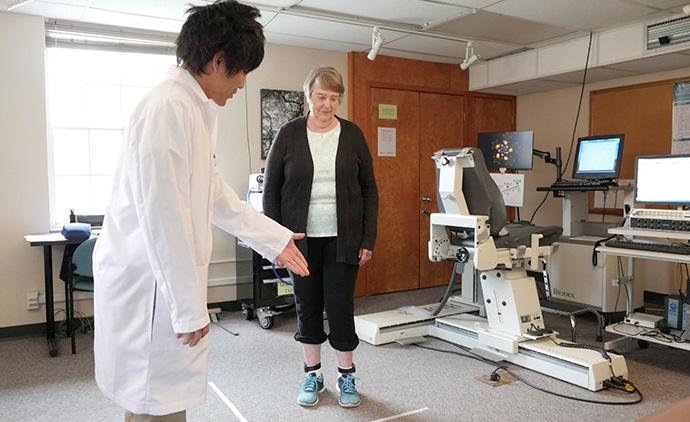
Facilities
Ohio University
Established in 1804, Ohio University (OHIO) is the oldest public institution of higher learning in the state of Ohio and the first in the Northwest Territory of the United States. Admission to OHIO is granted to the best-qualified applicants as determined by a selective admission policy. OHIO has more than 40,000 students, including ~ 6,000 graduate and professional students. OHIO is fully accredited by the North Central Association of Colleges and Schools. OHIO is rated a Very High Research Activity Institution by the Carnegie Foundation, and researchers hold more than 250 patents worldwide. The university maintains state-of-the-art informatics systems and the main library contains more than 2.3 million bound volumes, 20,808 periodic subscriptions, and 3.5 million other materials. OHIO also participates in OhioLINK, a consortium of Ohio's college and university libraries and the State Library of Ohio, offering access to more than 31 million library items statewide. The departments and colleges with strong pertinence to health (e.g., Medicine, Health Sciences, Engineering, Psychology, Biology, etc.) are co-located on the West Green at Ohio University.
Ohio Musculoskeletal and Neurological Institute
The Ohio Musculoskeletal and Neurological Institute (OMNI) is consistently striving toward the development of innovative, integrated, and interdisciplinary team-based science that has the potential for bench-to-bedside-to-community impact. OMNI scientists conduct basic and clinical research pertaining to the advancement of musculoskeletal and neurological health. OMNI has strong programmatic efforts in two research programs: 1) musculoskeletal pain and injury (primary focus on rehabilitation), and 2) healthy aging (primary focus on frailty and fractures). The research across these programs has an overarching aim of developing interventions and diagnostics that remove barriers to independent physical mobility and ultimately reduce disability.
OMNI is a not a “location” per se, but rather a group of scientists, clinicians and engineers who collaborate together such that “the whole is greater than the sum of its parts.” To this end, OMNI scientists maintain a large number of laboratories on the Ohio University campus. Here, we highlight a few of our laboratory facilities as well as those that are associated with the Clinical and Translational Research unit (CTRU), a centralized facility to facilitate human subjects research at Ohio University.

Neuromuscular Physiology Laboratory & Brain Stimulation Laboratory
Director: Brian Clark, Ph.D.
This laboratory is located in Irvine Hall, which is adjacent to the CTRU. This lab is ~ 750 square feet and has the instrumentation and technical capabilities to: 1) assess and modulate cortical excitability and activity (e.g., single and paired-pulse transcranial magnetic stimulation (TMS), repetitive (including Theta Burst) TMS, transcranial direct current stimulation, and electroencephalography); 2) assess spinal reflexes and responsivity (e.g., H-reflexes, stretch reflexes, cervicomedullary-evoked potentials); 3) assess muscle activity, motor unit behavior and number, and nerve conduction (e.g., EMG-based recordings of interference patterns, single motor unit activity, motor unit number estimation, nerve conduction, etc.); 4) assess muscle strength, fatigue, and control (e.g., BioDex System 4 Dynamometer, MedX Knee Extension/Flexion Dynamometer, MedX Lumbar Extension Dynamometer, Numerous Force Transducers and Accelerometers); 5) assess skeletal muscle contractile properties and tissue characteristics (e.g., evoked muscle forces, instrumentation and expertise in obtaining and analyzing muscle biopsy samples).
Human Performance Laboratory
Director: Brian Clark, Ph.D.
This laboratory is located in Irvine Hall, and spans two rooms that total ~ 1,000 square feet. Additionally, this lab has a 50-meter long runway for assessing mobility. This laboratory has the instrumentation and technical capabilities to: 1) assess aerobic capacity and resting metabolic rate (e.g., metabolic system with integrated exercise equipment (treadmill & cycle); 2) assess mobility and physical function (e.g., dedicated areas for assessing chair rise time, stair climb power, gait speed and biomechanics (via the BioSensics LEGSys 5 sensor system), and physical activity (i.e., accelerometry); and conduct supervised exercise training sessions (i.e., this lab consists of necessary equipment to conduct resistance exercise training protocols as well as equipment for treadmill and cycle exercise protocols (Peloton Indoor Cycle Ergometer).
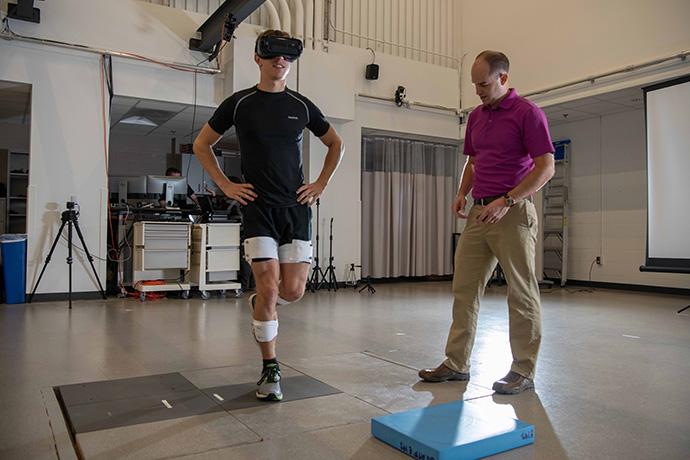
Applied Neuromechanics Laboratory
Directors: Dustin Grooms, Ph.D. and Janet Simon, Ph.D.
The Applied Neuromechanics Lab is located in Grover Center (~100 meters from Irvine Hall), and comprises over 2,000 square feet of equipment for testing and screening individuals of all ages and skill levels. This facility is designed for motion analysis of sports and daily activities. It includes a 15’x15’ open space with a passive optical motion capture system to allow natural walking, running, and jumping including: 12-camera Vicon passive optical motion capture system, 3 Bertec force plates embedded in the floor with 2 portable plates. The lab features multiple workstations with a full suite of human movement analysis software including: Matlab, Visual3D, SPSS, and Labview for data processing and storage.
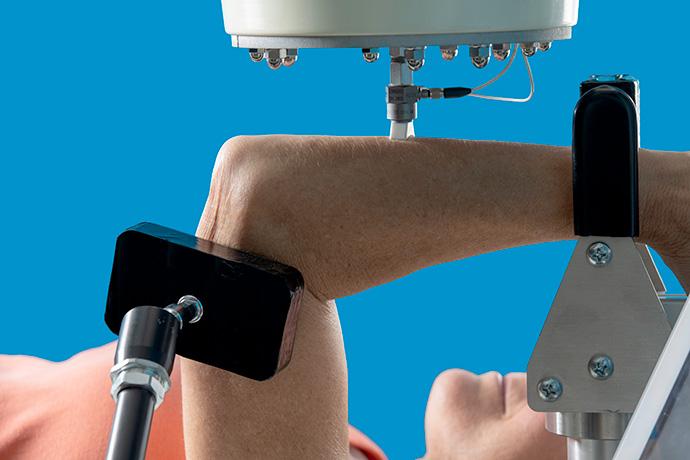
Endocrinology and Bone Biology Laboratory
Director: Anne B. Loucks, Ph.D.
The Loucks Lab is located on the ground and second floors of Irvine Hall and consists of 6 rooms that total 1950 square feet. 1. Human Subjects Lab. In this lab, a Cortical Bone Mechanics Technology (CBMT) device is used to test human subjects. 2. Cadaveric Arms Lab: In this lab, a CBMT device is used to test cadaveric human arms. 3. Image Analysis Lab: This lab is used to analyze computed tomography (CT) and micro-computed tomography (uCT) images of human bones. 4. Biochemistry Lab: This lab is used to process and store (a) blood samples that are assayed for metabolic substrates, hormones and markers of bone turnover, and (b) cadaveric human arms and tissue. The lab contains five freezers, a refrigerator, a fume hood, and diamond saw for sectioning bones. 5. Dissection Lab: This lab contains a stainless steel workbench and a stainless steel sink that are used for thawing and defleshing cadaveric human arms, for packaging bone tissue for cold storage, and for cleaning and disinfecting dissection equipment. This lab also has a refrigerator for temporary storage of tissue before it is transferred to freezers in the Biochemistry Lab. 6. Shared Lab: This lab shared with another faculty member contains two additional freezers used to store human tissue. Dr. Loucks also has access to a Biomaterials Lab. The lab contains a 10 kN Q-Test Elite Material Testing System (MTS Corporation; Minneapolis, MN), which is a tabletop electromechanical testing system. Servomotors control forces and test speeds. Computerized controllers manage test set-up, data capture, data analysis, and generation of test reports. The test machine and accompanying software are utilized for testing bones in tension, compression, or bending. A variety of load cells and gripping systems enable the testing of a wide range of sizes of bones and bone specimens.
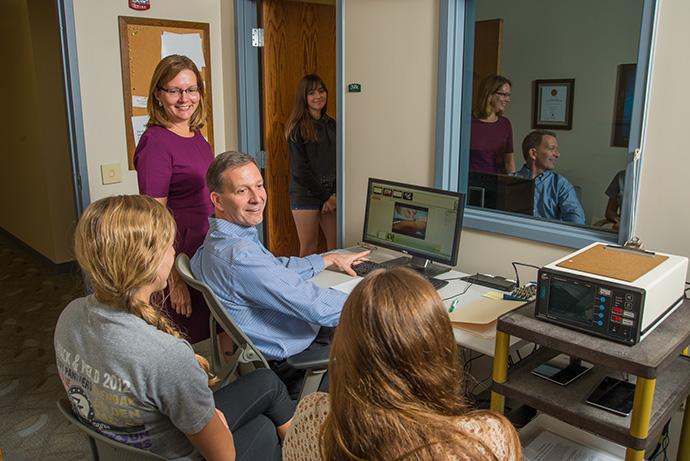
Clinical Psychophysiology Laboratory
Director: Christopher France, Ph.D.
This laboratory is located in Porter Hall (~ 100 meters from Irvine Hall) and includes a total of approximately 1200 square feet of research space that is divided into two four-room laboratory suites in the Department of Psychology, Ohio University. The laboratory has the instrumentation and technical capabilities to: 1) perform quantitative sensory testing using a variety of experimental pain and nociception paradigms, including the nociceptive flexion reflex, heat and cold pain test (i.e., cold pressor, thermode), ischemic pain, and electrocutaneous stimulation; 2) assess psychophysiological responsivity to stress (e.g., cardiovascular, electrodermal, respiratory, and electromyographic reactivity); and 3) conduct psychological assessment and interventions in person or remotely via telephone or computer.
Social Neuroscience and Pain (SNAP) Lab
Director: Dominik Mischkowski, Ph.D.
The SNAP lab space is located in Porter Hall (~150 meters from Irvine Hall) and covers two lab suites on the first and third level of the building, totaling ~ 1000 square feet. The lab space comprises a mix of individual and group session lab rooms designed to facilitate the collection of physiological, self-report, and behavioral data from participants of all sociodemographic ranges. The lab houses 11 computer workstations for physiological and self-report data collection using common recording and statistical analysis software, such as Acqknowledge and SPSS. The lab also houses equipment to induce moderate but tolerable physical pain, including a Hokanson Rapid Cuff inflation system to induce pressure pain. Finally, the lab contains a BioPac unit to take psychophysiological measures, including electrodermal activity (EDA), electrocardiography (ECG), infrared pulse, and respiration.
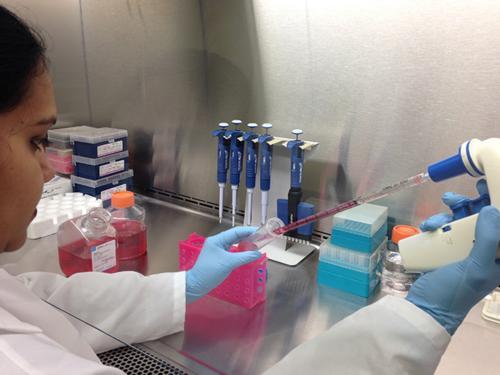
Muscle Physiology and Metabolism Laboratory
Director: Leslie Consitt, Ph.D.
This laboratory consists of ~2,000 net feet of space on the third floor of the Academic and Research Center (ARC) at Ohio University. This laboratory is fully equipped to perform physiological and metabolic analysis of skeletal muscle. The laboratory has an Oroboros Oxygraph used for high-resolution respirometry of permeabilized human and animal skeletal muscle tissue and cells. For protein analysis, the laboratory has a tissue homogenizer, sonicator and equipment to run numerous western blot procedures. The laboratory space contains 4 benches and routine laboratory equipment including: benchtop microcentrifuge, shaking water bath, vortexes, fume hood, heat plates, stirrers, western blot station, pH meter, rocker, orbital shaker, two 4°C refrigerators, -20°C and -80 freezers, cryostorage, deionized water purification system, and other standard laboratory equipment. Within 15 feet of Dr. Consitt’s personal laboratory space is a primary cell culture lab where satellite cells from human skeletal muscle tissue are isolated and grown into primary human myotubes for metabolic experiments. This cell culture room is equipped with a BSL II tissue culture hood, and 2 CO 2 incubators.
VITAL (Virtual Immersive Technologies for Active Living) Lab
Director: Chang Liu, Ph.D.
The VITAL Lab is located in the Botanical Research building, which is adjacent to Morton Hall and Scott Quad at Ohio University. Lab space includes a 700 sq. ft. room for computing equipment and a separate office. It supports scientific computing and artificial intelligence applications with three high-end servers with multiple top-of-the-line GPU cards. It also supports mobile development with several 27" iMac and PC workstations. In addition, it supports three-dimensional virtual reality development with devices such as Oculus Rift, Google Day Dreamer viewers, and Google Glass.
Bone Metastasis Research Laboratory
Director: Thomas Rosol, D.V.M., Ph.D., M.B.A.
The laboratory is located in the ARC research building that is shared by the Heritage College of Osteopathic Medicine and the Russ College of Engineering that fosters collaboration with biomedical engineers. The research labs in ARC are dedicated to molecular, cellular, and rodent research models. Rosol is an NIH-funded scientist that focuses on mechanisms of cancer metastasis to bone and discovery of new treatments for bone metastasis. Mouse models are used to investigate the pathogenesis of bone metastasis of human and animal cancers after injection of cells into the left cardiac ventricle or directly into bone medullary cavities. The laboratory uses in vivo bioluminescence (IVIS 100 imaging system) and microCT imaging to monitor metastasis in vivo and ex vivo. Deep sequencing transcriptomes and microRNAomes are used to discover important metastasis genes and pathways.

Medical Imaging Core
The CTRU manages a medical imaging core that provides access to two MRI’s, dual-energy x-rayabsorptiometry (DEXA), and ultrasongraphy instrumentation.
- 3.0 Tesla Phillips Achieva MRI : This MRI is located ~ 2 miles from Irvine Hall. It has the Phillips BOLD, FiberTrack and Neuroscience Specialist Research Software, and is interfaced with virtual reality-compatible visual stimulation goggles and MRI-compatible manual response devices that allow for integrating visual and auditory stimulus delivery with online behavioral measurement during MRI scanning.
- Esaote G-Scan Brio Weight-Bearing MRI : This low-field MRI is located within the CTRU facility and is ideally suited for imaging the musculoskeletal system. The MRI can be rotated in 1-degree increments to a complete upright position (i.e., 90 degrees) to permit imaging in weight-bearing positions.
- Hologic Discovery W DEXA : This DEXA scanner is located with the CTRU facility and is a switched-pulse dual-energy x-ray system with a multi-element array detector system. It is interfaced with Hologic’s QDR software and quantifies bone mineral density and content (while body and site specific), along with body composition with subregion body composition analysis options.
- BioSound MyLab 25 Ultrasonography : This portable ultrasound system features include multifrequency, broad bandwidth probes with frequencies ranging from 18 to 1 MHz; split screen with simultaneous 2D and color Doppler imaging; on board and integrated CD/DVD burning capability; and several output options including multimedia, DICOM and Native.
Other:
- Machine Shop : OMNI scientists have access to machine shops through both the Department of Physics and the College of Engineering at Ohio University.
- Biostatical Support : Janet Simon, PhD, serves as the Director of OMNI’s Biostatistics and Research Design Core. As part of the Biostatistics and Research Design Core statisticians have access to high-end computers with access to a variety of statistical software, including SAS 9.4 (SAS Institute Inc., Cary, NC), STATA 16 (StataCorp, College Station, TX), R (R-Core Team), and SPSS 24 (SPSS Inc., Chicago, IL). Additionally, the Ohio University Heritage College of Medicine’s Office of Research and Grants has biostatisticians available to support research.
The Ohio University Entrepreneurial Ecosystem
The Ohio University Technology Transfer Office works with startup and established businesses to move new technologies developed at Ohio University from the laboratory to the marketplace, for the benefit of society. The staff is skilled at identifying the market potential for faculty inventions, pursuing U.S. and international patent protection, securing industry partners that can commercialize university innovations, and providing business assistance for early-stage faculty startup companies. Ohio University ranks first among Ohio institutions of higher education for research licensing revenue. The university also ranks fourth in the nation after Princeton University, Northwestern University, and New York University for return on investment in research. Meanwhile TechGROWTH Ohio is a $52 million public-private partnership composed of the Ohio Third Frontier program, Ohio University and the private investment community providing business expertise, services and investments for startup companies in Southeastern Ohio. Executives-in-Residence from TechGROWTH Ohio offer business coaching and support, including business planning, market analysis, company formation, hiring, as well as legal and financial accounting issues. TechGROWTH Ohio is widely recognized as the gateway for technology entrepreneurs in Southeast Ohio. TechGROWTH Ohio’s extensive network of partners and collaborators has established a system of recruitment and referral, resulting in a robust pipeline of investable opportunities. Since 2008, TechGROWTH Ohio has provided operation assistance to 541 entrepreneurs and financial support to 93 companies to speed their path toward sustainable businesses, creating wealth, jobs, and economic activity in the region. In addition, the Ohio University Innovation Center provides valuable business incubation resources to startup companies. Created in 1983, the Innovation Center was the first university-based business incubator in the State of Ohio and just the 12th in the United States. It was recently named Rural Incubator of the Year (INBIA 2016), #3 Top University Incubator – United States (UBI Global), and #8 Top University Incubator - North America (UBI Global). The current 36,000 square foot facility provides a wide range of resources including office space, labs, and meeting space, all leased at competitive rates, flexible space and lease options intended to allow companies room to expand, rapid prototyping product development equipment and expertise, access to seasoned expert professionals for business coaching, and shared access to office equipment for printing, copying, faxing, scanning, high-speed Internet, conference phones and more.